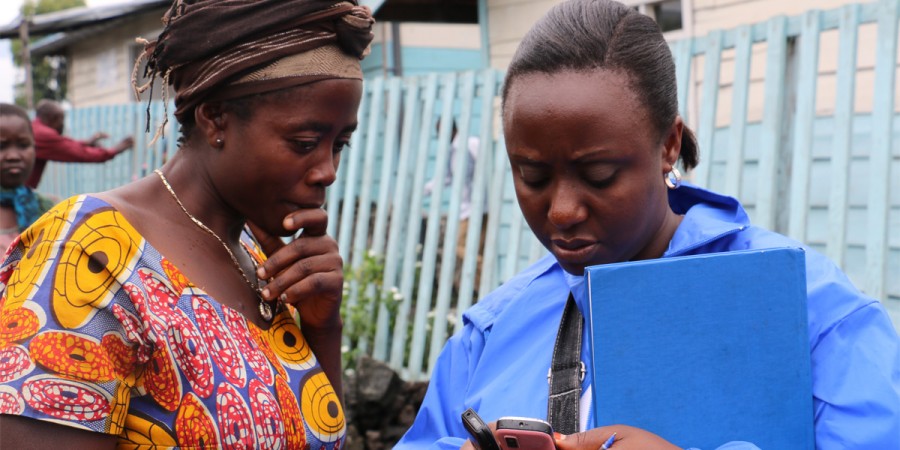In rural areas of the Democratic Republic of Congo (DRC), Africa’s second largest country with vast fertile lands and thousands of lakes, rivers and streams, one in ten people do not have enough food to eat. Food insecurity – the “availability and adequate access at all times to sufficient, safe and nutritious food to maintain a healthy and active life” – is one of the major consequences of the 20-plus year crisis that has plagued DRC, especially its eastern provinces. Twenty years of successive wars, skirmishes, rebellions have severely disrupted the entire food production industry.
In North Kivu Province, where more than 700,000 people are internally displaced, the World Food Programme (WFP) relies on new technology to monitor food security data among some of the country’s most vulnerable communities. Since 2014, WFP is using mobile phones and voice recognition software to regularly collect food security data.
The mobile Vulnerability Analysis and Mapping (mVAM) project has been implemented in 15 countries around the world, with the first-ever pilot taking place in Eastern DRC. The project has been successfully piloted in Mugunga III, a site hosting more than 4,600 internally displaced people (IDP) near Goma. This is just the beginning of mobile data collection in DRC. WFP is planning an expansion to other parts of the province in the coming months and price data collection is being rolled out nationally.
The idea behind mVAM is to remotely gather information on food access, consumption, prices, and household-level coping mechanisms, which allows WFP to better assess the food security situation in a given zone and provide emergency assistance when possible. Every month, WFP staff Mireille Hangi and Jean-Marie Kaseku call approximately 300 respondents residing in the Mugunga III IDP camp to ask them series of precise questions : “in the last seven days, how many days did you eat protein? Cereals? Fats?”. “If you didn’t have enough to eat, what coping strategies did you employ to have food to eat? Did you borrow money from a neighbor? Do you reduce adult family members’ rations? Do you decrease the frequency of your daily meals?”
In a country like DRC, where access to vulnerable populations is often hampered by the absence of roads and ongoing insecurity, remote data collection has proven to be a more flexible alternative. This process is faster and cheaper than traditional face-to-face interviews, which often cost between $20-40USD per household and take 4-6 weeks to transcribe and analyze. With mVAM surveys, the cost of a phone call is between $1-2 USD per household with a live operator from WFP and even less if using SMS.
According to WFP, the project demonstrated its usefulness where high rates of vulnerability and illiteracy prevail. WFP is able to better understand what people need, making its assistance more effective. It allows for real time data collection, providing a full overview from the beneficiaries themselves of changes in their food needs in a given area.
However, technology has its own challenges. For people living in a camp or in remote areas, access to electricity to charge the phone is a major issue. To overcome this, WFP installed a solar charging station in the camp and a committee elected among the survey respondents, manages matters related to charging issues.
An unintended benefit is that beneficiaries have learned how to use cell phones and are able to stay better connected to family members in other parts of the country. Each respondent receives $0.50USD in phone credit following the call as compensation for their time. This credit can be used by the beneficiary household to call family and friends outside of the camp. They also have greater access to information on prices and distribution dates and are able to express their questions and concerns via the two-way communication system.
Lessons learned from the mVAM experience in Mugunga III and across other countries where WFP works will be shared at the upcoming World Humanitarian Summit, which will take place in Istanbul, 23 – 24 May. But what is already clear is that new technologies are exploring new ways in order to better serve populations most in need. And this is just the beginning.


Comments